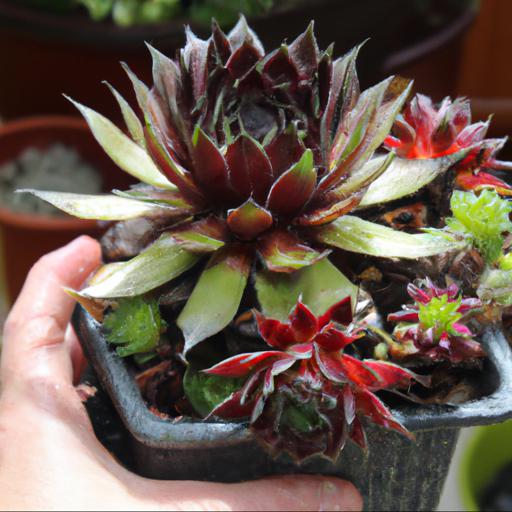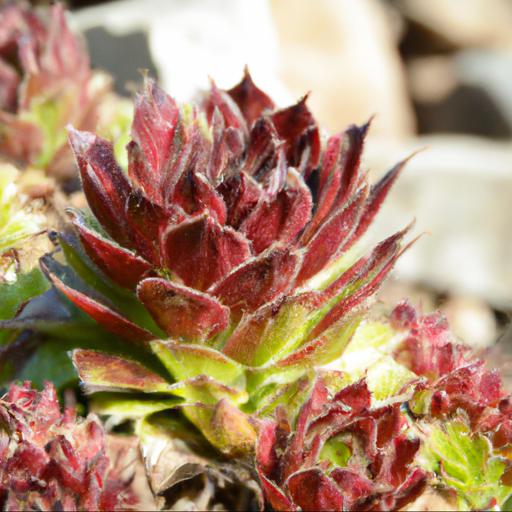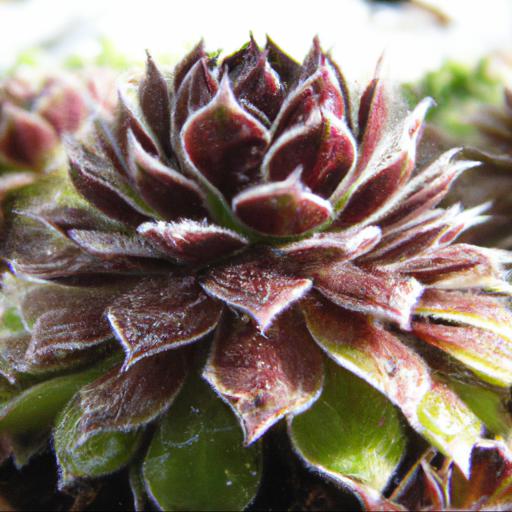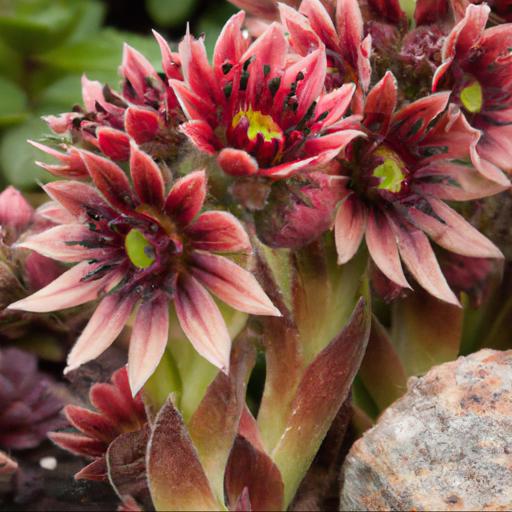Introducing Sempervivum gay jester, a unique and beautiful variety of succulent! This variety of succulent has stunningly vibrant, purple-tinged foliage and is an ideal choice for those looking to add an eye-catching addition to their garden.
The Sempervivum gay jester is low-maintenance, drought-tolerant, and can thrive in a variety of climates. It’s a great choice for gardeners of all levels, as it doesn’t require much care and attention. With its unique foliage and easy-care requirements, the Sempervivum gay jester is the perfect succulent for anyone looking to add a touch of beauty to their garden.
Growing and caring for sempervivum gay jester

Caring for Sempervivum Gay Jester, an evergreen perennial, is an easy task that can bring years of delight to a UK garden. Combining a cheerful variegated foliage with vibrant rosettes, it’s no wonder that this plant is so popular.
Exploring the details of growing and caring for this stunning Sempervivum will ensure a healthy and prolific display of color and texture all season long. The first step to successful Sempervivum gardening is to ensure the plants have a bright, full-sun location with well-draining soil. Too little sunshine will result in tethered growth, and poor drainage can lead to root rot.
A dry, sunny spot will provide the best environment in which this plant can thrive and reach its full potential. Caring for an established Sempervivum with optimal conditions will require minimal intervention.
Water deeply in spring and summer to encourage new growth, but allow the surface soil to dry out before repeating. During winter months, an occasional sprinkle of water every 3-4 weeks will help protect the foliage from harsh weather. Removing any yellow or dead leaves will also help maintain a neat display.
In the UK, it may be necessary to provide a layer of mulch over the soil, as this will help protect the plant’s root system, as well as hold in the heat during the winter months. It is also important for gardeners to remember to not crowd the plants too much, as overhanging foliage can block light and decrease air circulation.
Finally, when propagating and dividing the plants, ensure that there are enough healthy, strong specimens left to create an overall attractive display. Caring for Sempervivum Gay Jester is a simple but rewarding process. A UK garden that follows these tips will soon be rewarded with beautiful, deep green foliage highlighted with unique white, pink and purple rosettes.
With a little TLC, Sempervivum Gay Jester is sure to add a dose of beauty and cheer to any outdoor space.
Benefits of sempervivum gay jester

. Sempervivum Gay Jester is a variety of succulent plants that offer a variety of benefits to gardeners.
While they are not the most well-known plants, they are hard to resist due to their majestic, bright pink and yellow coloring. The succulents are native to Europe and belong to the sempervivum family. As with other succulents, Sempervivum Gay Jester is simple to grow and an ideal choice for beginner gardeners.
These plants require minimal care and can tolerate a wide range of soil types, making them an attractive, low maintenance solution for gardeners. They also require very little water and are drought tolerant, so little water is needed in the summer months. Additionally, Sempervivum Gay Jester is a great choice for gardeners in colder climates because it can survive temperatures as low as -40 degrees Fahrenheit.
Sempervivum Gay Jester is also a great choice for rock gardens and other sunny, dry gardens. Its cheerful-looking leaves add charm to any garden, and their unique shape and size make these plants stand out.
Because the blooms are long lived, Sempervivum Gay Jester can be used to create long-lasting arrangements or fill in any gaps in the garden. These succulents can also make great gifts for friends and family. All in all, Sempervivum Gay Jester is a great choice for both beginner and experienced gardeners.
Its minimal care and maintenance requirements, its hardiness in a wide range of climates, and its eye-catching appearance make this a great choice for nearly any garden.
Design ideas for sempervivum gay jester

. One of the most delightful and colorful plants in a garden could be Sempervivum gay jester.
This stunningly beautiful houseleek plant is a hybrid of Sempervivum tectorum and Sempervivum ‘Plum. It is both low-maintenance and low-cost. It is definitely one of the best succulent plants for adding flare and fun color to your garden.
The Sempervivum gay jester has spherical rosettes of jagged and lightly fuzzy leaves that can range in color from shades of reds, purples, creams, and yellows. These rosettes can become up to three inches in diameter and can continue to divide and form new succulent rosettes for an interesting and ever-changing display. The foliage’s shape and texture make them look jagged and even sometimes clown like, which can really bring a fun aspect to outdoor spaces.
Beyond those attractive attributes, this low-maintenance houseleek is also a great choice for sunny or partially sunny gardens. It is drought tolerant and requires minimal watering.
Its care requirements are easy to meet as it only asks for a light amount of water and should be kept in warmer climates. For anyone looking to bring some brilliantly hued succulents to their garden, the Semperivivum gay jester is an excellent choice. While it is a bit of a different hue than what we might be used to with succulents, its color and free-flowing shape allow this eye-catching plant to complete any garden with style and grace.
Troubleshooting common problems with sempervivum gay jester
Are you having trouble getting your Sempervivum Gay Jester to thrive in your UK garden? Often known as Houseleek and Hen and Chickens, this charming variety of succulent requires some unique insights to grow successfully and create an everflowing mass of dreamy purple and green foliage. Here’s what you should know about troubleshooting the common problems for the Sempervivum Gay Jester.
Firstly, the Sempervivum Gay Jester relies on ample sunlight for at least 5-6 hours per day. If your UK garden lacks in bright sunshine, then the Sempervivum will struggle and its lush foliage will be stunted.
But if you are all set with a sunny place for your Sempervivum, then you should give it a soil composed of a combination of half loess and half garden soil, with a pinch of sand. If left in a single soil type, then such rich variation in texture will be missing and the Sempervivum will suffer.
Secondly, overwatering your Sempervivum Gay Jester would also punish its foliage severely. It needs a good amount of water to survive, but let the soil dry out between waterings and avoid soggy soil. This succulent can also be sensitive to weather, so if summer arrives suddenly with brutal heat and you haven’t provided your Sempervivum the protection of a wind shield, then the foliage may quickly wither away.
Finally, if the Sempervivum Gay Jester has been living in a pot long enough, then it is time to re-pot the rootball. Every couple of years you might check if the roots don’t nearly reach the edge of the pot, and fill in new soil with a well-draining formula.
This will prevent the roots from getting too cramped up in the pot. The Sempervivum Gay Jester has some unique features, so it does require a bit extra care than the other garden plants. With the right combination of soil and sun, and with occasional repotting when required, along with controlled irrigation, you can keep your Sempervivum Gay Jester happy!
Bottom Line
Sempervivum gay jester is a unique variety of succulent with a striking foliage of vibrant colors. The plant’s leaves are a mix of deep red, purple, and green, and its rosettes form a star-shaped pattern. It is an easy-care plant that is perfect for rock gardens, containers, or as an accent in any garden.
With its minimal water and sun requirements, this is a great choice for novice gardeners.
FAQ
What is the scientific name of Sempervivum Gay Jester?
The scientific name of Sempervivum Gay Jester is Sempervivum ‘Gay Jester’.
What are the characteristics of Sempervivum Gay Jester?
Sempervivum Gay Jester is a succulent plant with bright green leaves that form rosettes. The leaves have a purple hue and are covered in white hairs. It produces yellow flowers in the summer and can tolerate a wide range of temperatures. It is drought tolerant and requires minimal maintenance.
How does Sempervivum Gay Jester differ from other Sempervivum varieties?
Sempervivum Gay Jester differs from other Sempervivum varieties in that it has a unique color combination of green and purple foliage, as well as a more compact growth habit. It is also more tolerant of cold temperatures than other varieties.
What is the ideal climate for growing Sempervivum Gay Jester?
The ideal climate for growing Sempervivum Gay Jester is one that is sunny and dry with temperatures between 65-75°F (18-24°C).
How often should Sempervivum Gay Jester be watered?
Sempervivum Gay Jester should be watered once every two weeks.
What are the benefits of growing Sempervivum Gay Jester?
The benefits of growing Sempervivum Gay Jester include its drought-tolerance, low maintenance, and its ability to thrive in a variety of climates. Additionally, it is a beautiful and unique plant with its bright pink and green foliage.

